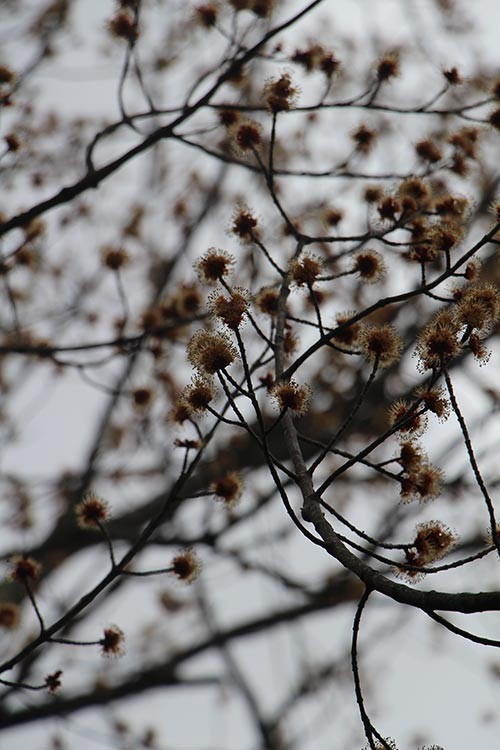Our farm bush shut down in early March, but the Hall bush is higher elevation and north facing and is still producing. We sold the sap we collected last week to a sugarmaker up the road, and when he stopped boiling we went back to processing the sap ourselves and made the last syrup of our season. It was light-colored but late-season-flavored. It tasted like the dark, reddish-colored stuff you sometimes make at the very end. The taste was predictable, but the color surprised me. I don’t know why it was so light.
This whole question of color and flavor illuminates a paradigm shift that’s going on in the industry, but to understand it you have to know the back story. See, for centuries the market paid a premium for light syrup. The roots of this go all the way back to the birth of the industry, when the product being produced was maple sugar. This maple sugar was marketed as a domestic, more moral version of slave-produced cane sugar. Higher prices were paid for light sugar because it was sweeter than dark sugar, and thus both flavorfully and aesthetically similar to cane sugar.
This bias transferred to the syrup market and, until very recently, light syrup was worth more than dark syrup. (In Vermont there was also a semantic prejudice, with the light stuff being called “Grade A Fancy” and the dark stuff being called “B.”) Since peoples’ tastes vary, and since it takes as much, and usually more, work to produce dark syrup than light syrup (more because the sugar content of the sap usually drops late in the year), the whole stratification was pretty dumb from a business perspective. Brewers don’t charge less for stout than pilsner just because it’s dark.
Today, in light of this logic, we have a new grading system in Vermont that allows us to call dark syrup “Grade A,” and in most sugarhouses the price is the same regardless of grade. I’m all for this. Things do get a little tricky this time of year, though, because you get to a point in some seasons when the syrup quality starts to suffer. In the old days there was a point at which syrup got too dark to put in retail jugs. This was something of a protection for consumers, because really dark syrup starts to take on funky tastes, some of which are not so good. Sugarmakers call it “buddy,” because it corresponds with the trees breaking bud, which changes the physiology of the sap, and with the microbial loads that accompany warm weather, which also affect flavor. Today there is no color restriction on what we can sell retail, though, which means that it’s up to the sugarmaker to distinguish between good-tasting dark syrup and off-tasting dark syrup.
What makes things even trickier is that technologies like high-vacuum pumps and improved spout design are allowing sugarmakers to make syrup longer into the season than they used to, which often means they’re making more off-flavored syrup; it also means lighter syrup that has off flavors. Color used to be a cheat sheet sugarmakers could use to help judge syrup taste. When it was coming off light we could pretty much be on auto-pilot, but we knew that when it got to be really dark, or red-colored, that we needed to be really discriminating about flavor. Over the past five years in our operation, though, we haven’t made much, if any, really dark syrup.
The syrup we made last week was a light amber color and smooth, but instead of the sugary maple taste someone would expect, it had a butterscotch finish that clung to the roof of your mouth. We’ll sell it to a packing house as processing grade and probably get around $17 a gallon for it. But you can see the potential for a conflict of interest here. If we put that same syrup in a retail container we could sell it for $60 a gallon (though we may not get many repeat customers). If you’ve ever bought funky tasting syrup, that’s probably what happened, and it’s not always a case of a sugarmaker being unscrupulous. It’s human nature, when you put a lot of work into something, to delude yourself into thinking it’s alright. The lines between off, marginal, and good can be pretty fine, especially if you’re overtired and sick of tasting syrup after a whole season of it.
The way to navigate this as a syrup consumer is to buy local and talk with your sugarmaker about the syrup you’re buying. Learn what you like and learn the conditions in which it was made. There’s a basic flavor profile for early season syrup, mid-season syrup, and late-season syrup, and he or she will be able to set you up with syrup made in the right time frame. We have one customer for whom we know to set aside the lightest syrup we make in any year, and another who likes it so dark he wants it bitter. This year, as per his request, we sent him unfiltered late-season syrup. He wanted sludge.
Don’t know a local sugarmaker? This weekend will be a great time to go meet one if you live in Vermont or New York. Both states are holding their annual maple open house weekends, and lots of sugarhouses will be officially open to the public. Click here for a list of participating sugarmakers in Vermont, and here for the New York list. Or, just drive around and look for open house signs.



Discussion *